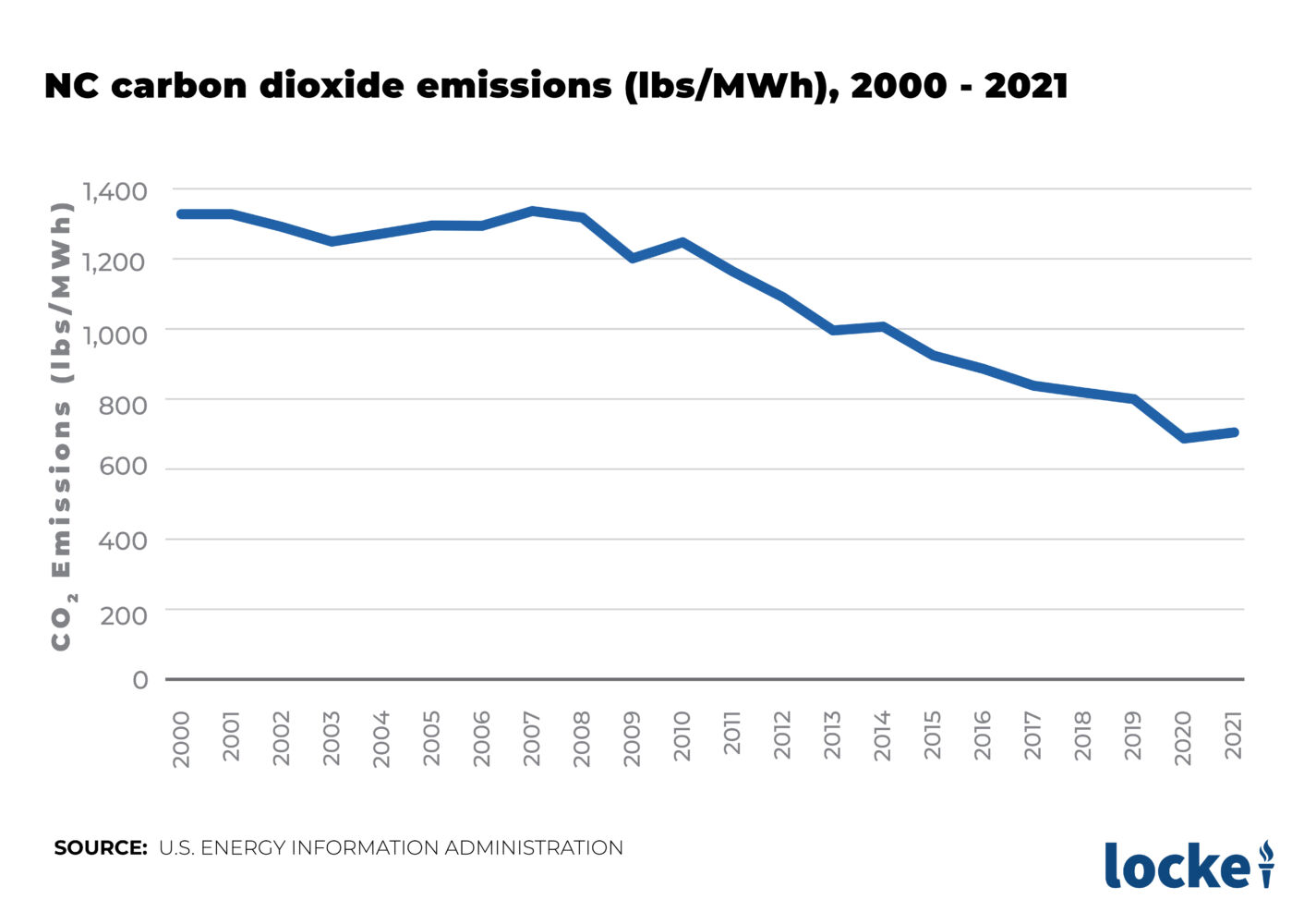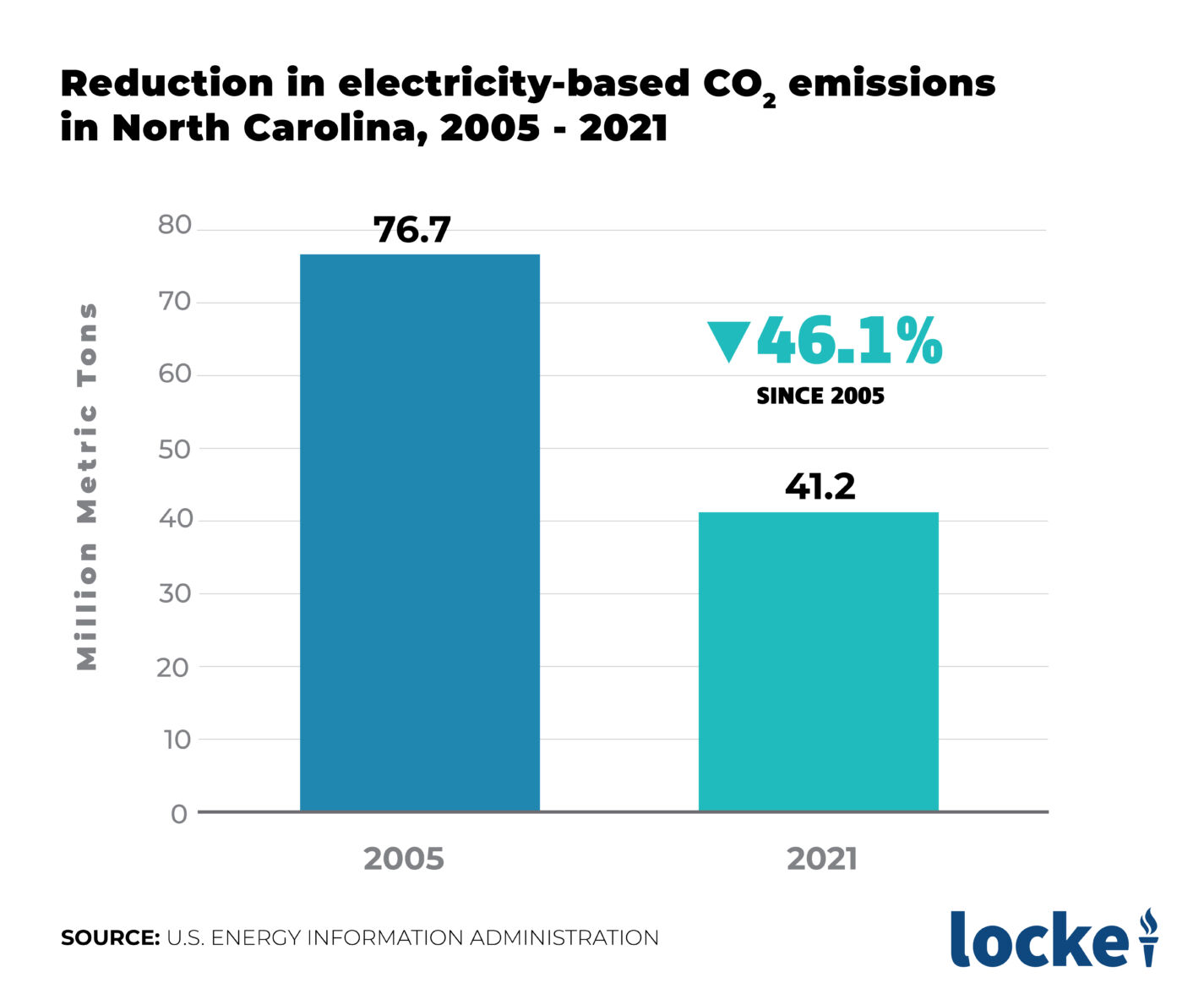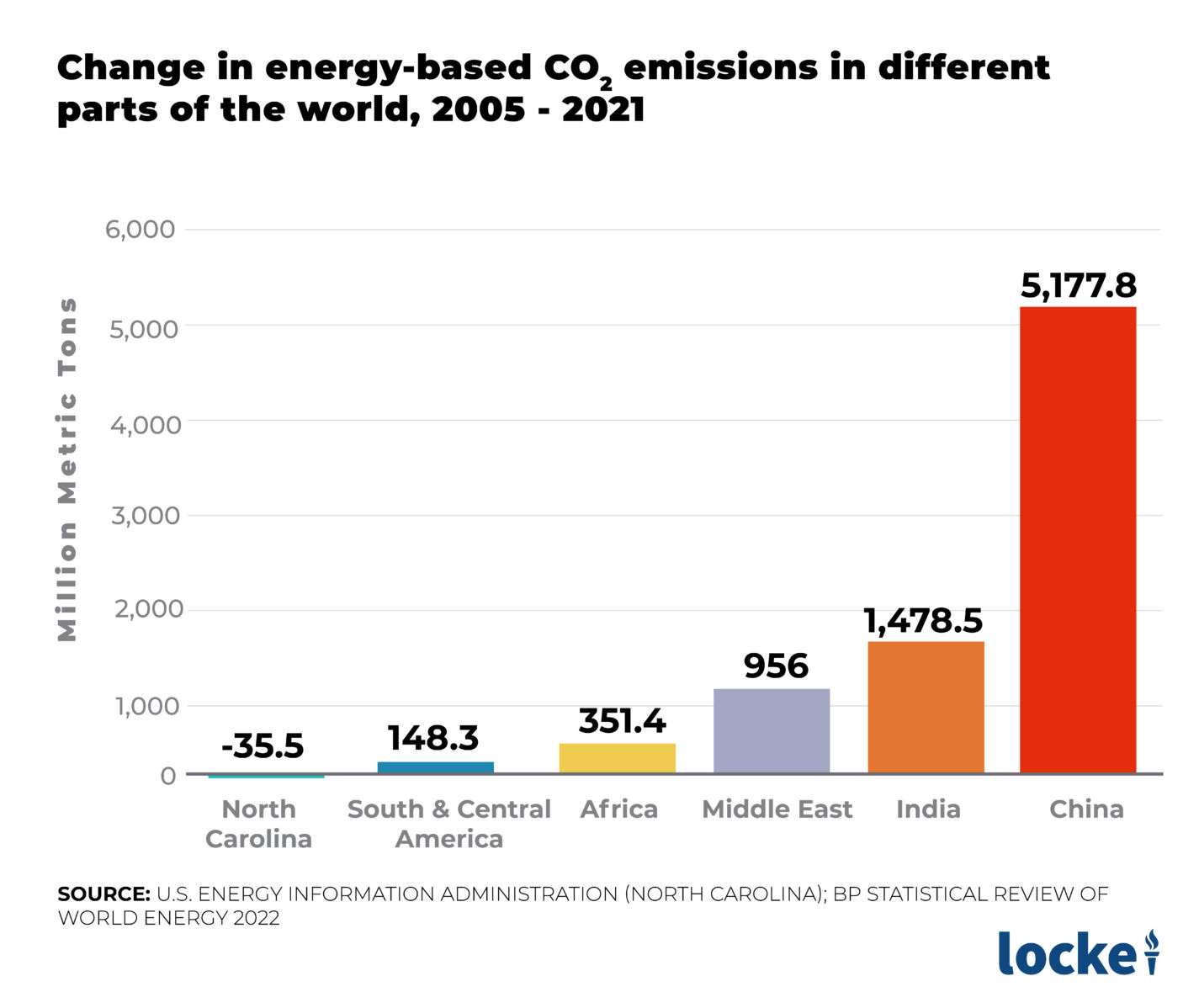- The belief that North Carolina’s electricity-based CO2 emissions are still going up is wrong; they’ve fallen by 46.1 percent since 2005
- The belief that North Carolina could positively impact the world’s climate by cutting its remaining, globally miniscule emissions is also wrong
- For no possible climate benefit, policymakers can still make North Carolinians materially worse off trying to force the elimination of the state’s remaining emissions
At year’s end 2022, the North Carolina Utilities Commission (NCUC) revealed the initial Carbon Plan in compliance with a 2021 state law passed by the legislature and signed by the governor. In the name of “fighting climate change,” the plan seeks to chart a path first to a 70 percent reduction from 2005 levels in carbon dioxide (CO2) emissions from electricity generation in North Carolina by around 2030, then to “carbon neutrality” by 2050.
At the core of the Carbon Plan is replacing all of North Carolina’s coal-fired power capacity, because barring a breakthrough in carbon capture technology, coal is the greatest source of CO2 emissions from electricity. The Carbon Plan would retire over 9,000 MW of coal-fired capacity in North Carolina by 2035, admittedly at great expense to North Carolinians.
Outside estimates of Carbon Plan scenarios range from $141.7 billion to $162.3 billion through 2050, with average household bills increasing from $1,030 to $1,140 per year.
Electricity touches everything. Not only is it a basic household necessity, one that people cannot do without, but it is also an input in every conceivable good and service provided in this state. Making electricity more expensive therefore negatively affects everyone and every business. It leaves families with less money available to spend on other needs, it causes the price of goods and services to increase, and it also leaves businesses with less money available for paying their workers or hiring new ones.
Behind it all is the idea that global CO2 emissions are worsening the world’s climate, which ignores the great uncertainty in the science behind it (see, e.g., physicist and former Obama undersecretary for science Steven E. Koonin’s book “Unsettled: What Climate Science Tells Us, What It Doesn’t, and Why It Matters”). Building on that idea, several beliefs underlie the drive for such an enormously expensive, deeply impactful change to electricity provision in North Carolina. They are:
- North Carolina’s electricity-based CO2 emissions are still going up, so extreme policy measures are necessary to reverse them
- North Carolina can positively affect the world’s climate outcomes by lowering electricity-based CO2 emissions
- Given predictions of terrible outcomes from climate change in the future, there is no price too high for North Carolinians to pay now for lowering their electricity-based CO2 emissions
All these beliefs are false.
North Carolina’s CO2 emissions are down significantly — and have been falling all century
North Carolina’s CO2 emissions have been falling — and not just recently, but all this century, and not just by a little bit, but significantly.
NC carbon dioxide emissions (lbs/MWh), 2000–21

Since 2005 (the benchmark year in the law), North Carolina’s CO2 emissions from electricity have fallen by 46.1 percent, from 76.7 million metric tons to 41.2 million metric tons in 2021. A 2017 report from Locke demonstrated that market forces — technological change, consumer preferences, and especially the fracking revolution — were driving this outcome. Those factors persist.
North Carolina’s CO2 emissions from electricity, 2005 and 2021

North Carolinians should therefore expect that decline in CO2 emissions would continue — without the need for expensive governmental intervention.
North Carolina cannot impact the world’s climate — not even by eliminating our remaining electricity-based CO2 emissions
This fact is a hard truth, but responsible policymakers simply must face it head-on. North Carolina’s CO2 emissions have already been cut nearly in half, but we are supposed to think climate outcomes are worsening from emissions and we are the ones not “doing enough” to stop them.
The problem with this thinking is that it doesn’t matter where CO2 emissions come from. Emissions from anywhere in the world mix globally in the troposphere.
North Carolina’s part of the globe is very, very small. We comprise only 0.027 percent of the world’s surface area. In our teeny spot on the planet, we could achieve “carbon neutrality” — we could even cease to exist altogether — but it would make no discernible change on the global climate whatsoever. Whether we cut our remaining 41.2 million metric tons of CO2 emissions or didn’t even get to 70 percent emissions reductions, it would not make a difference.
Emissions data from around the world show the impossibility of the situation. Even at 100 percent, North Carolina’s cut in CO2 emissions would be paltry. The most we could cut is 76.7 million metric tons, and we have only 41.2 million metric tons left to go. In contrast, here is what other places around the world (which comprise significant portions of the globe) have added to their stock of emissions since 2005, according to the BP Statistical Review of World Energy 2022:
- South and Central America: +148.3 million metric tons
- Africa: +351.4 million metric tons
- The Middle East: +956.0 million metric tons
- India: +1,478.5 million metric tons
- China: +5,177.8 million metric tons

Recall that the Carbon Plan would close 9,000 MWs of coal-fired capacity in North Carolina by 2035. Pakistan’s energy minister just announced plans to quadruple Pakistan’s coal-fired electricity generation from 2,300 MW to 10,000 MW. Bangladesh recently announced adding 4,300 megawatts (MW) of new coal-fired power capacity. That’s already 12,000 MW in new coal capacity overriding whatever climate benefit North Carolina’s expensive Carbon Plan could yield. But that’s not all.
Bloomberg reported that global usage of coal “reached an all-time high in 2022.” Germany recently reopened five coal plants, and other European nations have increased their demand for coal power as well. India has not only shelved its plans to cut back on coal use, but just invoked an emergency law calling for maximum output from all coal plants.
And China? They have announced adding 270,000 MW in new coal capacity the next five years — 30 times the total amount of coal-fired power that North Carolina can possibly retire.
North Carolinians must be protected from expensive, unreliable electricity
Contrary to the beliefs listed above, the facts are:
- North Carolina’s electricity-based CO2 emissions have been going down all this century, without needing policy interventions
- North Carolina cannot affect the world’s climate outcomes by further lowering — or even eliminating entirely — our globally miniscule amount of CO2 emissions
- For no possible climate benefit, policymakers can still make North Carolinians materially worse off trying to force the elimination of the state’s remaining electricity-based CO2 emissions
The law behind the Carbon Plan requires the “reasonable,” “least cost path” to emissions reductions with “least cost planning of generation” that would “maintain and improve upon the reliability of the grid.”
The extent to which lawmakers and policymakers uphold those legal strictures will be the extent to which they protect North Carolinians from the negative unintended consequences of the Carbon Plan and the erroneous beliefs beneath it.


